Zhixiang Chi
Distribution Alignment for Fully Test-Time Adaptation with Dynamic Online Data Streams
Jul 16, 2024Abstract:Given a model trained on source data, Test-Time Adaptation (TTA) enables adaptation and inference in test data streams with domain shifts from the source. Current methods predominantly optimize the model for each incoming test data batch using self-training loss. While these methods yield commendable results in ideal test data streams, where batches are independently and identically sampled from the target distribution, they falter under more practical test data streams that are not independent and identically distributed (non-i.i.d.). The data batches in a non-i.i.d. stream display prominent label shifts relative to each other. It leads to conflicting optimization objectives among batches during the TTA process. Given the inherent risks of adapting the source model to unpredictable test-time distributions, we reverse the adaptation process and propose a novel Distribution Alignment loss for TTA. This loss guides the distributions of test-time features back towards the source distributions, which ensures compatibility with the well-trained source model and eliminates the pitfalls associated with conflicting optimization objectives. Moreover, we devise a domain shift detection mechanism to extend the success of our proposed TTA method in the continual domain shift scenarios. Our extensive experiments validate the logic and efficacy of our method. On six benchmark datasets, we surpass existing methods in non-i.i.d. scenarios and maintain competitive performance under the ideal i.i.d. assumption.
Adapting to Distribution Shift by Visual Domain Prompt Generation
May 05, 2024Abstract:In this paper, we aim to adapt a model at test-time using a few unlabeled data to address distribution shifts. To tackle the challenges of extracting domain knowledge from a limited amount of data, it is crucial to utilize correlated information from pre-trained backbones and source domains. Previous studies fail to utilize recent foundation models with strong out-of-distribution generalization. Additionally, domain-centric designs are not flavored in their works. Furthermore, they employ the process of modelling source domains and the process of learning to adapt independently into disjoint training stages. In this work, we propose an approach on top of the pre-computed features of the foundation model. Specifically, we build a knowledge bank to learn the transferable knowledge from source domains. Conditioned on few-shot target data, we introduce a domain prompt generator to condense the knowledge bank into a domain-specific prompt. The domain prompt then directs the visual features towards a particular domain via a guidance module. Moreover, we propose a domain-aware contrastive loss and employ meta-learning to facilitate domain knowledge extraction. Extensive experiments are conducted to validate the domain knowledge extraction. The proposed method outperforms previous work on 5 large-scale benchmarks including WILDS and DomainNet.
Test-Time Domain Adaptation by Learning Domain-Aware Batch Normalization
Dec 15, 2023Abstract:Test-time domain adaptation aims to adapt the model trained on source domains to unseen target domains using a few unlabeled images. Emerging research has shown that the label and domain information is separately embedded in the weight matrix and batch normalization (BN) layer. Previous works normally update the whole network naively without explicitly decoupling the knowledge between label and domain. As a result, it leads to knowledge interference and defective distribution adaptation. In this work, we propose to reduce such learning interference and elevate the domain knowledge learning by only manipulating the BN layer. However, the normalization step in BN is intrinsically unstable when the statistics are re-estimated from a few samples. We find that ambiguities can be greatly reduced when only updating the two affine parameters in BN while keeping the source domain statistics. To further enhance the domain knowledge extraction from unlabeled data, we construct an auxiliary branch with label-independent self-supervised learning (SSL) to provide supervision. Moreover, we propose a bi-level optimization based on meta-learning to enforce the alignment of two learning objectives of auxiliary and main branches. The goal is to use the auxiliary branch to adapt the domain and benefit main task for subsequent inference. Our method keeps the same computational cost at inference as the auxiliary branch can be thoroughly discarded after adaptation. Extensive experiments show that our method outperforms the prior works on five WILDS real-world domain shift datasets. Our method can also be integrated with methods with label-dependent optimization to further push the performance boundary. Our code is available at https://github.com/ynanwu/MABN.
Hyper-Skin: A Hyperspectral Dataset for Reconstructing Facial Skin-Spectra from RGB Images
Oct 27, 2023Abstract:We introduce Hyper-Skin, a hyperspectral dataset covering wide range of wavelengths from visible (VIS) spectrum (400nm - 700nm) to near-infrared (NIR) spectrum (700nm - 1000nm), uniquely designed to facilitate research on facial skin-spectra reconstruction. By reconstructing skin spectra from RGB images, our dataset enables the study of hyperspectral skin analysis, such as melanin and hemoglobin concentrations, directly on the consumer device. Overcoming limitations of existing datasets, Hyper-Skin consists of diverse facial skin data collected with a pushbroom hyperspectral camera. With 330 hyperspectral cubes from 51 subjects, the dataset covers the facial skin from different angles and facial poses. Each hyperspectral cube has dimensions of 1024$\times$1024$\times$448, resulting in millions of spectra vectors per image. The dataset, carefully curated in adherence to ethical guidelines, includes paired hyperspectral images and synthetic RGB images generated using real camera responses. We demonstrate the efficacy of our dataset by showcasing skin spectra reconstruction using state-of-the-art models on 31 bands of hyperspectral data resampled in the VIS and NIR spectrum. This Hyper-Skin dataset would be a valuable resource to NeurIPS community, encouraging the development of novel algorithms for skin spectral reconstruction while fostering interdisciplinary collaboration in hyperspectral skin analysis related to cosmetology and skin's well-being. Instructions to request the data and the related benchmarking codes are publicly available at: \url{https://github.com/hyperspectral-skin/Hyper-Skin-2023}.
MetaGCD: Learning to Continually Learn in Generalized Category Discovery
Aug 21, 2023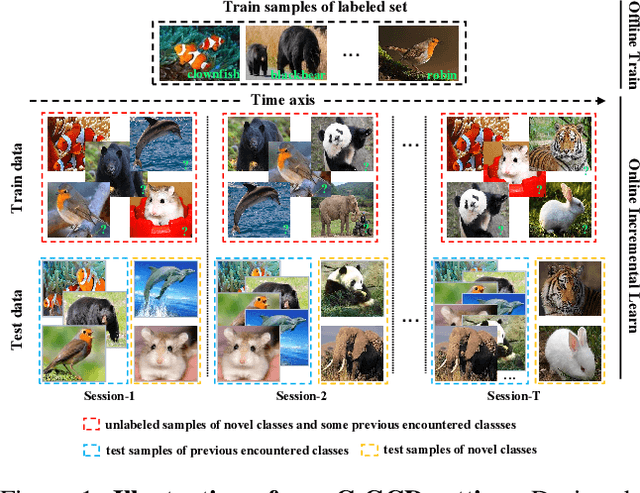
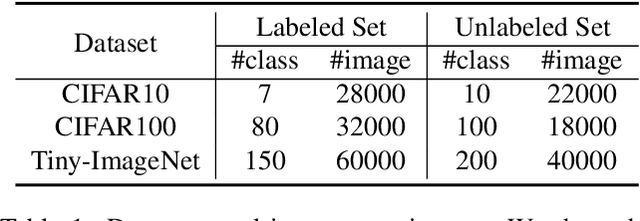

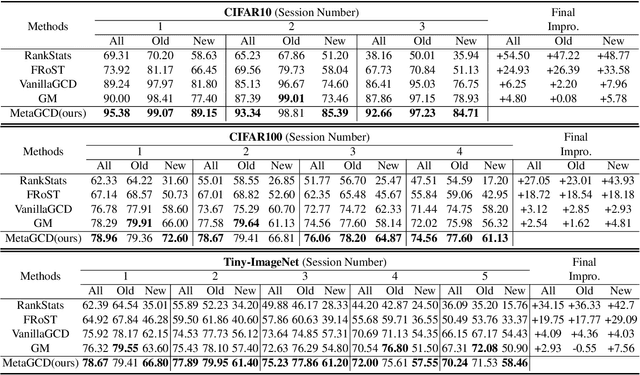
Abstract:In this paper, we consider a real-world scenario where a model that is trained on pre-defined classes continually encounters unlabeled data that contains both known and novel classes. The goal is to continually discover novel classes while maintaining the performance in known classes. We name the setting Continual Generalized Category Discovery (C-GCD). Existing methods for novel class discovery cannot directly handle the C-GCD setting due to some unrealistic assumptions, such as the unlabeled data only containing novel classes. Furthermore, they fail to discover novel classes in a continual fashion. In this work, we lift all these assumptions and propose an approach, called MetaGCD, to learn how to incrementally discover with less forgetting. Our proposed method uses a meta-learning framework and leverages the offline labeled data to simulate the testing incremental learning process. A meta-objective is defined to revolve around two conflicting learning objectives to achieve novel class discovery without forgetting. Furthermore, a soft neighborhood-based contrastive network is proposed to discriminate uncorrelated images while attracting correlated images. We build strong baselines and conduct extensive experiments on three widely used benchmarks to demonstrate the superiority of our method.
Meta-DMoE: Adapting to Domain Shift by Meta-Distillation from Mixture-of-Experts
Oct 08, 2022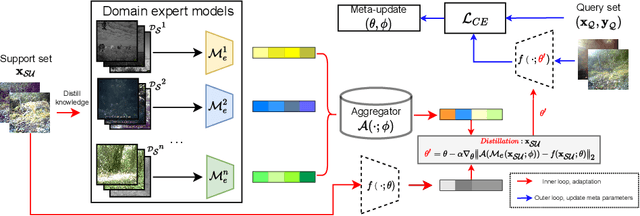

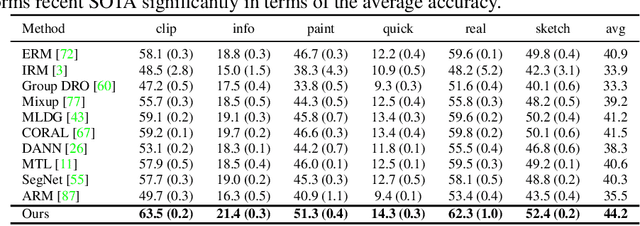

Abstract:In this paper, we tackle the problem of domain shift. Most existing methods perform training on multiple source domains using a single model, and the same trained model is used on all unseen target domains. Such solutions are sub-optimal as each target domain exhibits its own speciality, which is not adapted. Furthermore, expecting the single-model training to learn extensive knowledge from the multiple source domains is counterintuitive. The model is more biased toward learning only domain-invariant features and may result in negative knowledge transfer. In this work, we propose a novel framework for unsupervised test-time adaptation, which is formulated as a knowledge distillation process to address domain shift. Specifically, we incorporate Mixture-of-Experts (MoE) as teachers, where each expert is separately trained on different source domains to maximize their speciality. Given a test-time target domain, a small set of unlabeled data is sampled to query the knowledge from MoE. As the source domains are correlated to the target domains, a transformer-based aggregator then combines the domain knowledge by examining the interconnection among them. The output is treated as a supervision signal to adapt a student prediction network toward the target domain. We further employ meta-learning to enforce the aggregator to distill positive knowledge and the student network to achieve fast adaptation. Extensive experiments demonstrate that the proposed method outperforms the state-of-the-art and validates the effectiveness of each proposed component. Our code is available at https://github.com/n3il666/Meta-DMoE.
Improving ProtoNet for Few-Shot Video Object Recognition: Winner of ORBIT Challenge 2022
Oct 01, 2022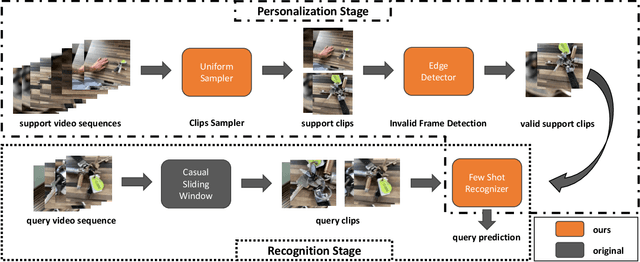

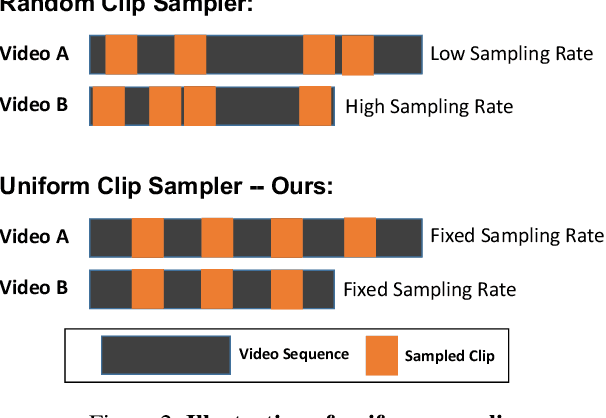
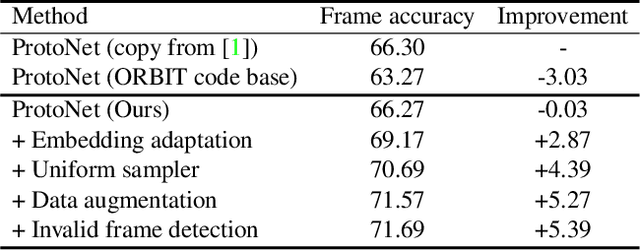
Abstract:In this work, we present the winning solution for ORBIT Few-Shot Video Object Recognition Challenge 2022. Built upon the ProtoNet baseline, the performance of our method is improved with three effective techniques. These techniques include the embedding adaptation, the uniform video clip sampler and the invalid frame detection. In addition, we re-factor and re-implement the official codebase to encourage modularity, compatibility and improved performance. Our implementation accelerates the data loading in both training and testing.
Error-Aware Spatial Ensembles for Video Frame Interpolation
Jul 25, 2022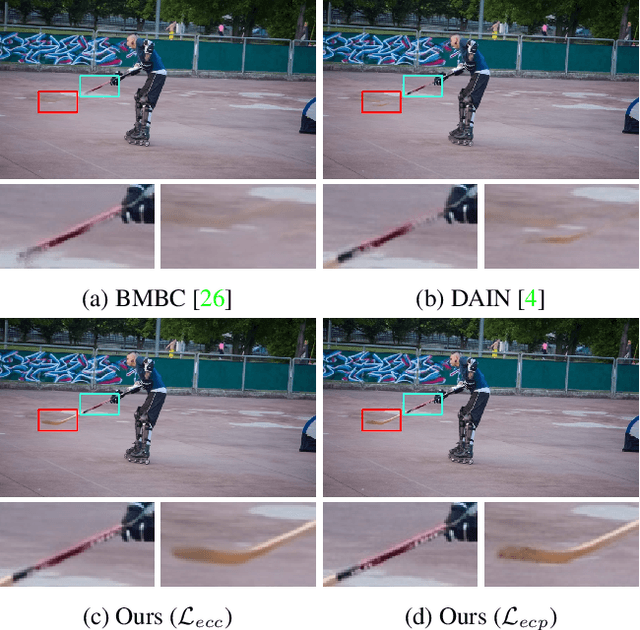

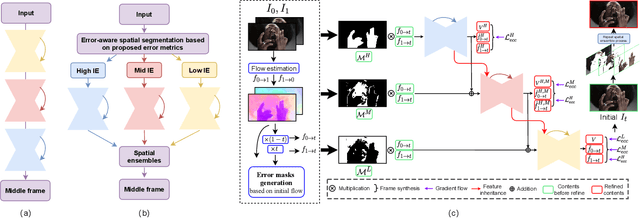

Abstract:Video frame interpolation~(VFI) algorithms have improved considerably in recent years due to unprecedented progress in both data-driven algorithms and their implementations. Recent research has introduced advanced motion estimation or novel warping methods as the means to address challenging VFI scenarios. However, none of the published VFI works considers the spatially non-uniform characteristics of the interpolation error (IE). This work introduces such a solution. By closely examining the correlation between optical flow and IE, the paper proposes novel error prediction metrics that partition the middle frame into distinct regions corresponding to different IE levels. Building upon this IE-driven segmentation, and through the use of novel error-controlled loss functions, it introduces an ensemble of spatially adaptive interpolation units that progressively processes and integrates the segmented regions. This spatial ensemble results in an effective and computationally attractive VFI solution. Extensive experimentation on popular video interpolation benchmarks indicates that the proposed solution outperforms the current state-of-the-art (SOTA) in applications of current interest.
Few-Shot Class-Incremental Learning via Entropy-Regularized Data-Free Replay
Jul 22, 2022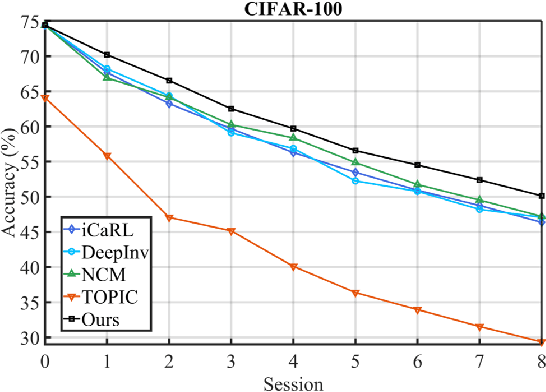
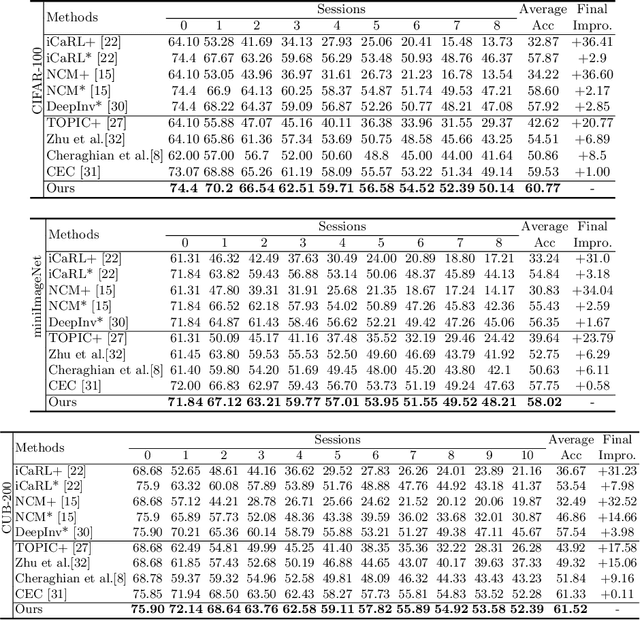


Abstract:Few-shot class-incremental learning (FSCIL) has been proposed aiming to enable a deep learning system to incrementally learn new classes with limited data. Recently, a pioneer claims that the commonly used replay-based method in class-incremental learning (CIL) is ineffective and thus not preferred for FSCIL. This has, if truth, a significant influence on the fields of FSCIL. In this paper, we show through empirical results that adopting the data replay is surprisingly favorable. However, storing and replaying old data can lead to a privacy concern. To address this issue, we alternatively propose using data-free replay that can synthesize data by a generator without accessing real data. In observing the the effectiveness of uncertain data for knowledge distillation, we impose entropy regularization in the generator training to encourage more uncertain examples. Moreover, we propose to relabel the generated data with one-hot-like labels. This modification allows the network to learn by solely minimizing the cross-entropy loss, which mitigates the problem of balancing different objectives in the conventional knowledge distillation approach. Finally, we show extensive experimental results and analysis on CIFAR-100, miniImageNet and CUB-200 to demonstrate the effectiveness of our proposed one.
Self-supervised Spatiotemporal Representation Learning by Exploiting Video Continuity
Jan 10, 2022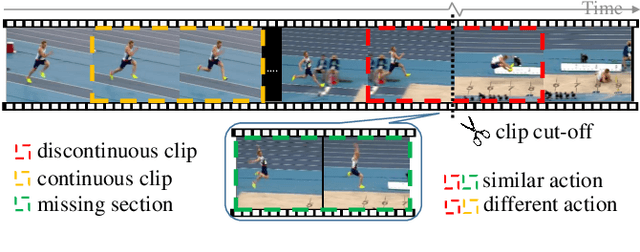
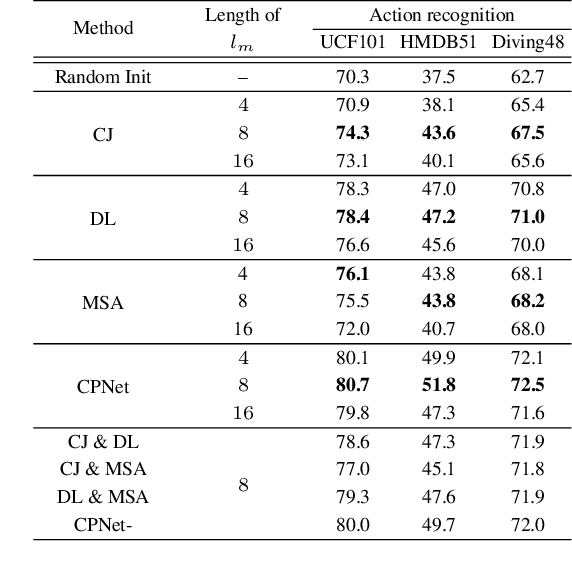
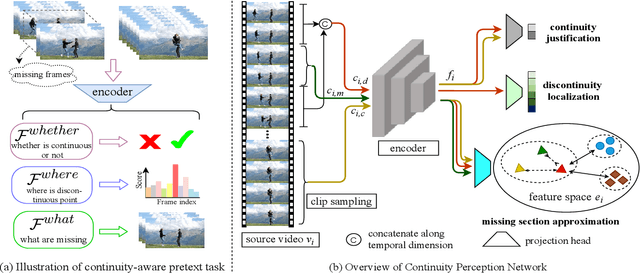

Abstract:Recent self-supervised video representation learning methods have found significant success by exploring essential properties of videos, e.g. speed, temporal order, etc. This work exploits an essential yet under-explored property of videos, the video continuity, to obtain supervision signals for self-supervised representation learning. Specifically, we formulate three novel continuity-related pretext tasks, i.e. continuity justification, discontinuity localization, and missing section approximation, that jointly supervise a shared backbone for video representation learning. This self-supervision approach, termed as Continuity Perception Network (CPNet), solves the three tasks altogether and encourages the backbone network to learn local and long-ranged motion and context representations. It outperforms prior arts on multiple downstream tasks, such as action recognition, video retrieval, and action localization. Additionally, the video continuity can be complementary to other coarse-grained video properties for representation learning, and integrating the proposed pretext task to prior arts can yield much performance gains.
 Add to Chrome
Add to Chrome Add to Firefox
Add to Firefox Add to Edge
Add to Edge